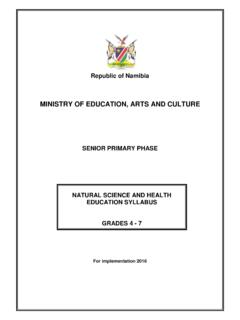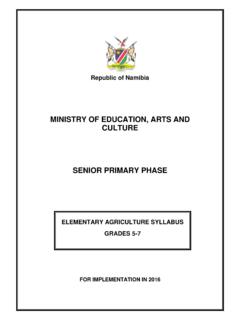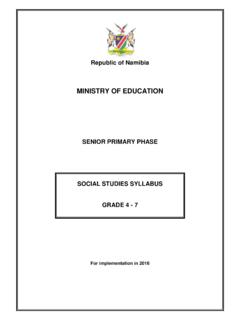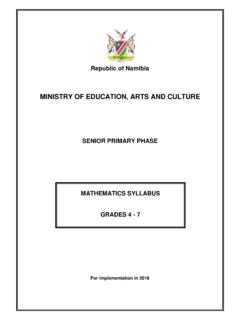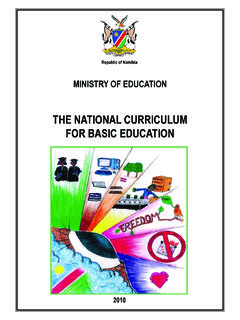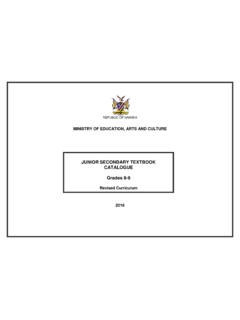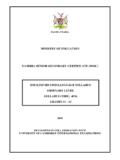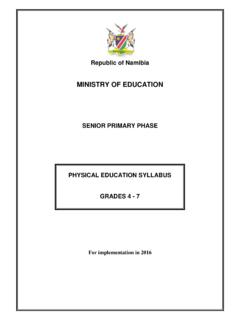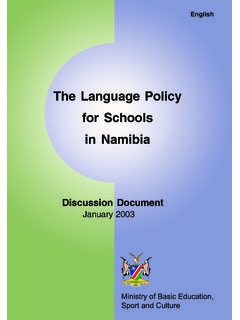Transcription of MINISTRY OF EDUCATION JUNIOR PRIMARY PHASE: …
1 Republic of namibia MINISTRY OF EDUCATION JUNIOR PRIMARY PHASE: SYLLABUSES SECTION 3 ENGLISH SECOND LANGUAGE MATHEMATICS FOR IMPLEMENTATION 2015 GRADES 1 - 3 ENGLISH VERSION i MINISTRY of EDUCATION National Institute for Educational Development (NIED) Private Bag 2034 Okahandja namibia Copyright NIED, MINISTRY of EDUCATION , 2014 Section 3: (Mathematics and English Second Language) ISBN: 978-99945-2-050-3 978-99945-2-058-9 Printed by NIED Website: Publication date: 2014 ii CONTENTS ENGLISH SECOND LANGUAGE 1 MATHEMATICS SYLLABUS 33 Republic of namibia MINISTRY OF EDUCATION JUNIOR PRIMARY PHASE FOR IMPLEMENTATION 2015 ENGLISH SECOND LANGUAGE SYLLABUS GRADES 1 - 3 2 English Second Language Syllabus, NIED, 2015 TABLE OF CONTENTS 1.
2 Introduction 3 2. Rationale 3 3. Aims 3 4. Inclusive EDUCATION 3 5. Links to Other Subjects and Cross-curricular Issues 4 6. Approach to Teaching and Learning 5 7. End of phase competencies 7 8. Learning Content 9 9. Assessment 28 3 English Second Language Syllabus, NIED, 2015 1. Introduction This syllabus describes the intended learning and assessment for English Second Language in Grades 1 to 3 of the JUNIOR PRIMARY Phase. As a subject, English Second Language is within the linguistic and literary area of learning in the curriculum, but has thematic links to other subjects across the curriculum. The aims, learning objectives, and competencies which overlap between subjects are amongst the essential learning within the curriculum as a whole. Under optimal circumstances, this subject would need 5 (Grades 1 and 2) and 9 (Grade 3) number of periods per week.
3 2. Rationale English is the official language of namibia and its acquisition is an essential life skill and unifying force in the multi-lingual and multi-cultural society of namibia . It therefore has a special place and function in EDUCATION . English Second Language is taught as a subject from Grade 1 to Grade 3 and, during upper PRIMARY , English becomes the medium of instruction and learning. It is therefore essential for all learners who are not home language speakers of English, to learn the language to enable them to cope with the demands of EDUCATION and real life in namibia . The particular features of English Second Language at this phase are the four language skills of listening and responding, speaking and communicating, reading and viewing, and writing.
4 A fifth area of language structure, grammar and language use is integrated into the four skills in order to develop the learners abilities to use English correctly. The emphasis at this stage is on language learning for communication, reading with understanding, and creative writing. Introducing learners to English Second Language as a subject in Grade 1 should be done in an informal and gradual way and should be based on informal approaches, such as carefully structured play-like activities, games rhymes and song which focus on specific language functions, notions, structures, sounds or skills. As learners progress through Grades 2 and 3, the subject will focus closely on developing what they need to use in English as a medium of instruction in future grades but in an engaging and motivational way.
5 3. Aims The aims of English Second Language are to: enable learners to function adequately in English as a medium of instruction in later grades; give learners the skills to consolidate and extend basic English for further progression in EDUCATION ; start developing learners competence in English as the official language in public life. 4. Inclusive EDUCATION Inclusive EDUCATION is the right of every learner and promotes participation in, or access to, the full range of educational programs and services offered by the EDUCATION system in mainstream schools. It is based on the principle of supporting and celebrating the diversity found among ALL learners and removing ALL barriers to learning. 4 English Second Language Syllabus, NIED, 2015 Basic EDUCATION prepares the society, as envisaged in namibia s Vision 2030, by promoting inclusivity.
6 Learners experiencing barriers to learning and other individual needs will be included in a mainstream school and their needs will be attended to through differentiation of teaching methods and materials as required. Learners, who are so severely impaired that they cannot benefit from attending inclusive schools, will be provided for according to their needs in learning support units, resource units or resource schools until such time that they can join the inclusive school where applicable. The curriculum, teaching methods and materials are adapted for learners in these institutions. The learner-centred approach to teaching is highly suitable for learners with special learning needs since it capitalises on what learners already know and can do, and then assists them to acquire new knowledge and skills.
7 The curriculum framework for Inclusive EDUCATION specifies the competencies which learners with special learning needs should master. Individual Learning Support Plans (ILSP) should be in place to guide and evaluate the individual learning process for learners with special learning needs. Further guidelines on planning for learning and teaching in an inclusive classroom can be found in the Curriculum Framework for Inclusive EDUCATION : A Supplement to the National Curriculum for Basic EDUCATION 2014. These guidelines will help to equip ALL learners with knowledge, skills and attitudes to help them succeed in the world that is increasingly complex, rapidly changing and rich in information and communication technology. The JUNIOR PRIMARY Phase promotes equal opportunity for males and females, enabling both to participate equally.
8 Teachers should know and understand how to treat learners equally, and all materials should support gender fairness. Girls tend to be more proficient in language than boys in JUNIOR PRIMARY and female and males have differences in the way they apply language. These differences can be used as a resource by grouping girls and boys together during language lessons. Value issues such identity, feelings, choices and conflicts are often discussed during language sessions. The different attitudes about values that shape male and female thinking can be used to enrich classroom discussion. 5. Links to Other Subjects and Cross-curricular Issues The cross-curricular issues including Environmental Learning; HIV and AIDS; Population EDUCATION ; EDUCATION for Human Rights and Democracy (EHRD), Information and Communication Technology (ICT) and Road Safety have been introduced to the formal curriculum to be dealt with in each subject and across all phases because each of the issues deals with particular risks and challenges in our Namibian society.
9 All of our learners need to: understand the nature of these risks and challenges know how they will impact on our society and on the quality of life of our people now and in the future understand how these risks and challenges can be addressed on a national and global level understand how each learner can play a part in addressing these risks and challenges in their own school and local community The main risks and challenges have been identified as: the challenges and risks we face if we do not care for and manage our natural resources the challenges and risks caused by HIV and AIDS the challenges and risks to health caused by pollution, poor sanitation and waste the challenges and risks to democracy and social stability caused by inequity and governance that ignores rights and responsibilities the challenges and risks we face if we do not adhere to Road Safety measures the challenges and risks we face from globalisation 5 English Second Language Syllabus, NIED, 2015 Since some subjects are more suitable to address specific cross-curricular issues, those issues will receive more emphasis in those particular syllabuses.
10 In this syllabus there are more examples of other links to cross-curricular issues, but only one example for each cross- curricular issue is provided below: Environmental Learning HIV and AIDS EHRD ICT Road Safety Grade 1: Listening and Responding: Listen to and learn a poem about the weather Grade 2: Listening and Responding: Listen to a story about caring for a sick person. Answer simple questions Grade 3: Writing: Write a story about a family custom Grade 3: Reading: Use the Internet to find information Grade 1: Speaking and Communicating: Use a picture to answer yes/no questions, Can he cross the road? No, he can t 6. Approach to Teaching and Learning The approach to teaching and learning is based on a paradigm of learner-centred EDUCATION (LCE) described in ministerial policy documents and the LCE conceptual framework.
